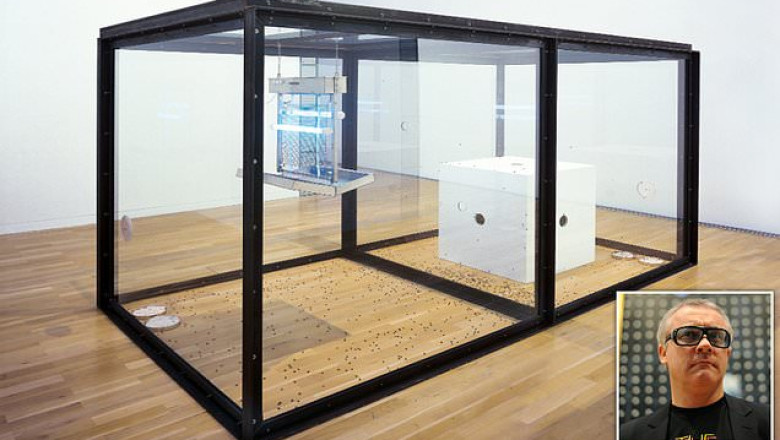
views
Damien Hirst art with fly-killing light removed for harming insects
By Adam Solomons For Mailonline
A piece by famed British artist Damien Hirst was taken down after animal rights campaigners complained that a UV light inside was killing flies.
'A Thousand Years' (1990) features two connected glass cases, one with a box where flies and maggots hatch and another which contains a UV light.
Flies hatch and make their way toward the light before being zapped.
The iconic work was removed from display at Kunstmuseum Wolfsburg, northern Germany this week after PETA and the city's veterinary office expressed opposition.
A tamer version of 'A Thousand Years' than has previously been displayed, PETA and Wolfsburg's veterinary office nevertheless campaigned for the work to be removed - and won
Famed artist Hirst, 57, is reportedly Britain's wealthiest living artist (file image)
They claimed the piece violated Germany’s Animal Welfare Act, which outlawed the killing or harming of animals 'without good reason'.
A PETA representative said: 'Killing animals has nothing to do with art, it just shows the arrogance of people who literally will stop at nothing for their own interests.'
Museum director Andreas Beitin said: 'We thought that flies didn’t come under the Animal Welfare Act.'
Previous versions of the work have included a rotting cow's head below the light, but this did not feature at the Kunstmuseum display.
Mr Hirst, whose work is often centred around death, has described the piece as 'a life cycle in a box'.
It's thought the British artist's works have featured one million dead animals, most of them insects.
His most famous work, 'The Physical Impossibility of Death in the Mind of Someone Living' (1991), is a preserved tiger shark encased in glass.
Legend has it that post-war painter and Hirst's hero Francis Bacon once studied A Thousand Years for more than an hour.
The piece was first displayed at Bermondsey gallery Building One in 1990.
Hirst's collector and former friend Charles Saatchi reportedly stared open-mouthed at the work when it was first unveiled - before buying it.
A rotting cow's head featured prominently in a version unveiled at Tate Modern ten years ago
Hirst poses with the encased tiger shark, his most famous work, at Tate Modern in April 2012
More than 9,000 butterflies were killed during the six-month run of 'In and Out of Love' at Tate Modern in 2012.
The RSPCA slammed the 'so-called "art exhibition"' and said: 'There would be national outcry if such an exhibition involved any other animal – such as a dog.
'Just because it is butterflies we are talking about here, doesn’t mean they don’t deserve to be treated with kindness.'
Share what you think
The comments below have not been moderated.
The views expressed in the contents above are those of our users and do not necessarily reflect the views of MailOnline.
By posting your comment you agree to our house rules.
Do you want to automatically post your MailOnline comments to your Facebook Timeline?
Your comment will be posted to MailOnline as usual.




















Comments
0 comment